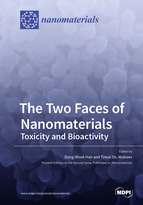The Two Faces of Nanomaterials: Toxicity and Bioactivity
A special issue of Nanomaterials (ISSN 2079-4991). This special issue belongs to the section "Biology and Medicines".
Deadline for manuscript submissions: closed (31 January 2020) | Viewed by 34761
Special Issue Editors
Interests: nanobiomaterials; tissue engineering; regenerative medicine; 3D bioprinting; cells/tissues/organs-on-chips; medical devices
Special Issues, Collections and Topics in MDPI journals
Interests: experimental nanochemistry, physics and applied nanotechnology (multifunctional nanomaterials for biomedical applications; solar cells; solar water splitting systems; nanomaterials engineering; optical materials; nanophotonics; nanosensor; nanoporous materials; photosynthesis; green chemistry; thin films; etc.)
Special Issues, Collections and Topics in MDPI journals
Special Issue Information
Dear Colleagues,
During the past two decades, a growing number of nanomaterials (NMs) have drawn keen attention due to the quantum leap in nanomedicine, which involves the use of various nanoparticles for therapeutic and diagnostic purposes. Furthermore, NMs have different properties than larger materials, and these properties can be utilized in a wide spectrum of biomedical areas, such as in theragnosis, drug delivery, imaging, sensing, and tissue engineering. In this context, it is of fundamental importance to evaluate the safety (or toxicity) profile of NMs and their impact on health in order to achieve their biocompatibility and desired activity for their development. In other word, NMs have double-sidedness, like the two faces of the medal.
In this Special Issue, we are especially interested in manuscripts that allow a better understanding the correlation of the biological effects of NMs to their intrinsic physicochemical and thermomechanical characteristics, as well as their opto-electrical properties. This Special Issue invites manuscripts that provide novel scientific findings on the bioactivity of NMs and some perspective on the possible risks to their future development in biomedical science and engineering.
Prof. Dr. Dong-Wook Han
Dr. Timur Sh. Atabaev
Guest Editor
Manuscript Submission Information
Manuscripts should be submitted online at www.mdpi.com by registering and logging in to this website. Once you are registered, click here to go to the submission form. Manuscripts can be submitted until the deadline. All submissions that pass pre-check are peer-reviewed. Accepted papers will be published continuously in the journal (as soon as accepted) and will be listed together on the special issue website. Research articles, review articles as well as short communications are invited. For planned papers, a title and short abstract (about 100 words) can be sent to the Editorial Office for announcement on this website.
Submitted manuscripts should not have been published previously, nor be under consideration for publication elsewhere (except conference proceedings papers). All manuscripts are thoroughly refereed through a single-blind peer-review process. A guide for authors and other relevant information for submission of manuscripts is available on the Instructions for Authors page. Nanomaterials is an international peer-reviewed open access semimonthly journal published by MDPI.
Please visit the Instructions for Authors page before submitting a manuscript. The Article Processing Charge (APC) for publication in this open access journal is 2900 CHF (Swiss Francs). Submitted papers should be well formatted and use good English. Authors may use MDPI's English editing service prior to publication or during author revisions.
Keywords
- nanomaterials
- nanomedicine
- toxicity
- bioactivity
- biomedical application








